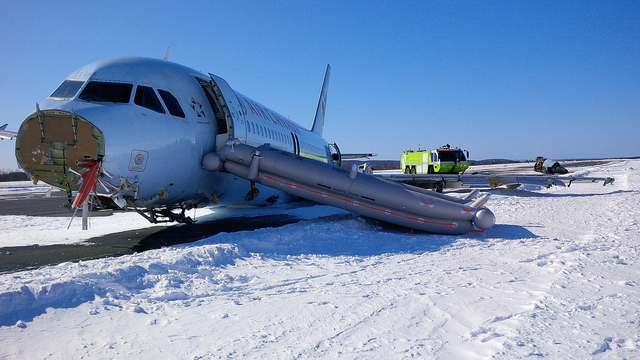Poor visibility, runway lighting issues and deficiencies in Air Canada's operating procedures caused the 2015 crash of an Airbus A320 at Halifax Stanfield International airport, Canada's Transportation Safety Board (TSB) concludes.
The crash, which occurred on landing during a snowstorm and at night, injured 25 of 138 passengers and crew on Air Canada flight 624 from Toronto.
It also led Air Canada to file a lawsuit against Airbus.
The aircraft (registration C-FTJP) drifted below its intended descent angle, striking lights, power lines and the ground ahead of Halifax Runway 05.
The TSB's final accident report, released 18 May, attributes the 29 March 2015 accident partly to Air Canada's standard operating procedures.
The carrier did not require pilots to monitor altitude and distance from the runway when the aircraft was beyond the final approach fix and flying in "flight path angle guidance mode", says the TSB's report.
That mode guides the aircraft along the flight path angle target – but wind variations and turbulence can lead the aircraft to drift from the target, says the board.
If the aircraft drifts below the approach target, the autopilot continues the decent at the same angle – but below the original path, horizontal to it, says the TSB.
A chart from the TSB's report showing how wind and turbulence can cause an aircraft to deviate from a flight path angle

Canada Transportation Safety Board
Such was the case with flight 624, which approached Halifax to land at about 00:30 local time in poor visibility.
"The flight crew did not notice that the aircraft had drifted below and diverged from the planned vertical descent angle flight profile, nor were they aware that the aircraft had crossed the minimum descent altitude further back from the threshold," says the report.
In addition, despite a request from the crew, airport control tower staff were preoccupied with other airport movements and did not turn the airport lights to their maximum settings, the TSB adds.
The pilots saw runway lights at the minimum descent altitude and continued the approach, expecting the lights to become more visible.
In the final seconds of flight, the pilots disengaged the autopilot for landing, then realised they were too low.
"Although they initiated a go-around immediately, the aircraft struck terrain short of the runway," says the TSB.
The aircraft struck runway lights, power lines and snow-covered ground about 226m before the threshold of runway 05.
It then struck the localiser antenna, hit the ground twice more and slid along the runway, stopping 579m beyond the threshold, says the TSB.
Passengers evacuated the damaged aircraft via slides.


TSB
The aircraft was written off as a total loss, according to Flight Fleets Analyzer.
In response to the accident, Air Canada provided pilots more-specific guidance related to visual references and warned of limitations to the autopilot and vertical navigation when using the aircraft's flight path angle mode, the TSB says.
The carrier also now requires instrument monitoring when below the minimum descent altitude, it adds.
Air Canada confirms in a media release that it made changes highlighted by the TSB, adding that it also is outfitting all Airbus narrowbodies with GPS and upgraded ground proximity warning technology.
The airport also upgraded approach lighting to Runway 05, reviewed its emergency response plan and upgraded backup power systems, says the TSB.
Airbus says it will not comment about the TSB's findings because of a pending legal case.
AIR CANADA SUES AIRBUS
Nearly two months ago, Air Canada filed a lawsuit against Airbus, claiming that failures by the manufacturer contributed to the 2015 crash.
Airbus "failed to clearly identify the shortcomings of the aircraft, in particular, the absence of a system to detect or correct a deviation from the planned and selected flight path angle", Air Canada said in court papers filed with the Supreme Court of Nova Scotia on 28 March.
Airbus "failed to adequately advise that in certain conditions the aircraft's flight path angle could be affected by external forces," documents say. "The defendant failed to incorporate a warning system to alert pilots to a deviation from the planned and selected flight path angle."
Source: Cirium Dashboard























